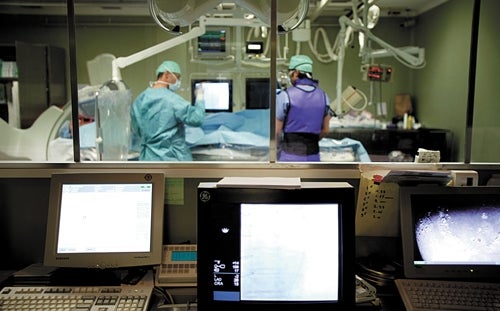It pleases no one to be sick or injured. Fortunately, if it happens near MetroWest, there’s a small consolation prize: One needs only to send a text message to find out how long the line is at the emergency room.
Metro West Medical Center launched that service in August as a means of keeping would-be emergency care patients informed about their hospital stays — even before they step through the doors.
The goal, said Marketing Director Stephanie Guidetti, is to create “a conversation with our patients…We want to be as transparent as possible and give people information.”
Judging from early results, the experiment showcases just how much of an appetite exists for the palatable combination of a willingness to be open and high technology. In roughly the first three months of use, nearly 2,500 texts were sent out to potential patients. That’s about one text for every nine people that visit the hospital’s emergency rooms in Framingham or Natick in a typical quarter. By any stretch, those results are promising.
But in another sense, they’re also just the tip of a far larger iceberg: The high-tech infused revolution reshaping the modern medical system across Central Massachusetts is taking place largely beneath the surface in ways that patients see indirectly, taxpayers fund significantly and most doctors and hospital administrators will remain under pressure to ramp up — especially in 2011, which generations hence, may be remembered in medical circles as the year the machines became hospitals’ real brains.
Acronyms & Medicine
Call it the year of the AMR (Ambulatory Medical Record). Call it the year of the CPOE (Computerized Physician Order Entry). Call it the year of the EMR (Electronic Medical Record). However one refers to it, the next 12 months will see a major growth in doctors’ use of computers, mobile devices, databases and other information technology tools designed to streamline orders for care, share information between different specialists and generally avoid the ire of federal and state regulators.
Two key factors drive this shift. One is essentially internal to the field of medicine — that is, coming from peers and competitors — which has widely embraced the idea that computerized ordering and record-keeping brings significant improvements in safety and the long-term cost savings needed to deliver better health care. The other is external — that is, from state and federal governments and health-care payers, all of which are mandating that health-care providers quickly rein in costs and improve outcomes. And in some cases, they have even put up money or made other resources available to pay for the conversion from a paper-based world to more versatile digital systems.
“This is a fundamental change in the process,” said Dr. William Muller, vice president of medical affairs at Milford Regional Medical Center, which has spent the better part of the last two years creating and then expanding a CPOE system that will eventually allow its more than 100 doctors to order tests and prescriptions directly from a computer and share those myriad orders across the hospital’s various departments.
But Muller said it’s a huge jump forward for doctors, who for generations recorded their orders on paper — which were then transcribed and disseminated. It’s quicker and easier for doctors to use paper, but far more prone to errors. An example? “Q.D.” a traditional abbreviation for “once daily” is just a slurred period away from being mistaken for ‘qid’, which means “four times daily.” That can be a real problem, especially since “doctors aren’t exactly known for their handwriting skills,” Muller said.
Given the potential for errors, Massachusetts has mandated that hospitals install CPOE by March 2012, which means the big ramp up for these systems will take place in 2011.
Fortunately for hospitals, the state has also made some assistance available to doctors and hospitals through the Westborough-based Massachusetts Technology Collaborative, which runs a program called CPOE University. Muller, “a proud graduate of that program,” said Milford Regional now has 80 percent of its doctors using CPOE and expects to be at or near 100 percent use by the end of the year.
It will be a big challenge for many this year, particularly in the region’s largest delivery system. UMass Memorial Health Care, with its 1,500 doctors, is the last of the state’s major hospital systems not using CPOE already, said Richard Cramer, associate chief information officer for operations Health Information Exchange at UMass.
But it’s part of a bigger, digital record-keeping challenge that Cramer said UMass — which a trade magazine recently dubbed one of the nation’s “Most Wired” hospitals — is already halfway through its five-year plan to tackle.
UMass is making waves for developing an electronic system — which includes at the moment patients’ medical and ambulatory care records — that fits the unique culture of health-care delivery in Central Massachusetts, where small, stand-alone doctors offices and groups are a substantial part of the UMass network.
They call it Cornerstone, a complicated digital behemoth that, when finished, will allow doctors and hospitals throughout UMass and its affiliates to share medical information across different digital systems. It’s even partnering with its vendor to help smaller doctors’ office to install and get up to speed with their own medical record-keeping systems.
The timing is key: The federal government has also mandated hospitals use electronic medical records — and included $19.2 billion in the 2009 stimulus bill to help doctors and hospitals pay for the upgrades. And those payouts start shrinking in 2011, which means savvy medical businesses may move quickly in the next year to get their installations started. That’s the carrot, but there’s also a stick: By 2015, penalties start to kick in for health-care organizations that have failed to go digital.
Kenneth St. Onge is a freelance writer based in Connecticut. He can be reached at ken@kenstonge.com.

